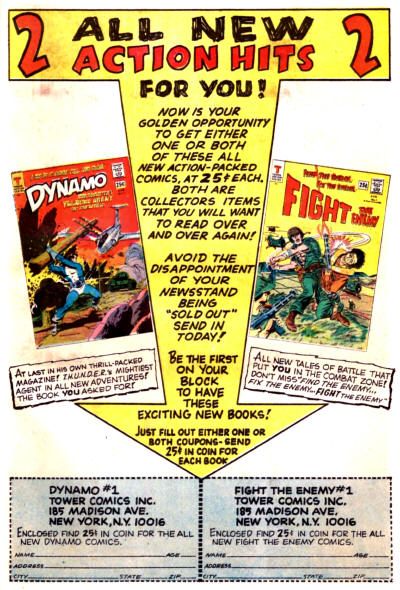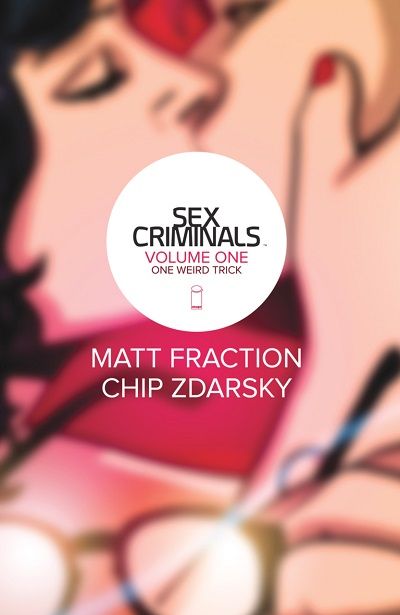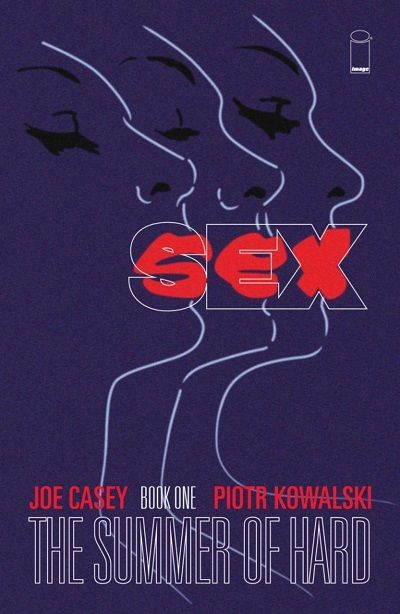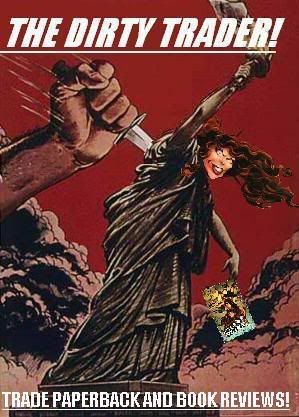T.H.U.N.D.E.R. Agents #6 (1966)
JCP Features The T.H.U.N.D.E.R. Agents #1
T.H.U.N.D.E.R. Agents #6 (2011)
T.H.U.N.D.E.R. Agents #6 (2014)
T.H.U.N.D.E.R. Agents #6 (Tower, 1966, 25¢)
In the interest of full disclosure, I have to point out that this issue was probably the first of the original Silver Age series I ever owned, purchased at SDCC in 2000 during my only wonderful trip there. There's a lot of positive association for me, but at the same time, I feel I can objectively say that it's a great issue. I don't know that I ever made the connection between the Red Dragon's appearance as I read it (a reprint story in #20 from issue #3) versus "Dynamo and the Sinister Agents of the Red Star," but this titular disciple put the original villain to shame. Red Star has a better costume, contrasting against Dynamo's blues, and his martial arts finesse allows him to work over the powerhouse using his own misguided muscles. For me, this is a quintessential Dynamo yarn, with troubled romance, job problems, very cheeky humor, charming Cold War super-spy tropes, and heroic difficulties that embarrass and stymie without making Len Brown look like a meathead. The women are strong, sexy and respectable, the villains cunning, and the art by Wally Wood and Dan Adkins stunning. I also have to point out the silent semi-splash where Dynamo is fired like a torpedo toward the enemy submarine. It's only two-thirds of the page, but by using the surrounding panels for set-up and the simple restraint of not using the same trick anywhere else in the story, it has vastly more impact than one of Ivan Reis' lovely but limp mini-portfolios DC has the nerve to call comic book these days.
Since I have the actual Tower comic for once, I'll point out the presence of a house ad here for Dynamo #1, which you could get free with a ten issue subscription commitment to T.H.U.N.D.E.R. Agents for just $2.50. It was strategically placed after the Dynamo story, opposite an ad for Balentine Books' Edgar Rice Burroughs collection. Later in the issue, they plug Dynamo #1 again as a twenty-five cent single issue direct mail offer to "Avoid the disappointment of your newsstand being 'sold out,'" along with Find the Enemy... Fix the Enemy... Fight the Enemy #1.
Given what a blatant rip-off of the Flash he is, and how I've never liked speedster characters, I have to admit that the Lightning strip was one of the most consistent in quality of the early going. Steve Skeates, Mike Sekowsky & Frank Giacoia clearly had a solid Flash run in them, and they were all moonlighting from DC Comics anyway, but absent that opportunity they deliver the goods here. Guy Gilbert is frankly not as bright as Barry Allen by half, but his military background offers a different path toward problem solving that entertains. Sekowsky brings his wily, rocky vibe to the premise, making up for the lack of Flash Facts with shaggy dog charm and a greater propensity for violent overtures. "The Origin of the Warp Wizard" could have easily been a dog, especially with the villain looking like Doc Brown on crack in a bland all purple get-up, but he sells himself with his wry grin and mad twinkle of the eye. It's still odd though how for a dude being slowly killed by his powers, Guy never once takes the Lightning costume off and seems completely disconnected from the T.H.U.N.D.E.R. Squad. I miss them.
"T.H.U.N.D.E.R. vs. Demo" once again answers questions I'm not sure anyone was asking, but Woody seemed bound to ride herd over the shoddy continuity between the strips in the team feature through the power of the retcon. Demo's appearance in the previous issue didn't seem like it was going to amount to much more than a Gil Kane showcase, but here it becomes the spine of a key event. Having gotten a taste for NoMan's invisibility, Demo sets out to steal all of Professor Jennings' creations from the individual super-agents, which sets off a string of events that returns his girl Friday Satana in a new role and would lead somewhat to a major character death in the next issue. Where I complained about the inks of Wally Wood & Dan Adkins overwhelming others, John Giunta's dated, cluttered style benefited much from their strong influence. Demo starts a line trope here, but there's cute wrinkles in this story that later derivative works could have used.
Speaking of John Giunta, Menthor became "his" character after Sekowsky moved permanently to the Lightning strip, and it did nothing to correct the character's disastrous drift off course. Menthor was the anti-Dynamo, Len Brown being a Peter Parker-like relatable schlub who was capable of overwhelming good, but only ever reaped the whirlwind of unlucky turns and harsh criticism for his efforts. John Janus was supposedly a virtual Adonis who pleased his superiors endlessly, but his stories always seemed to pivot on his being an arrogant douchebag who loses his telepathic helmet to one dubious dope after another. In "The Carnival of Death," the mentalist Zizaqz might as well have been the Entrancer in disguise, and he wasn't even targeting Menthor for a plot-- the idiot just created a situation Zizaqz could exploit. As usual, Janus spends most of the tale trying to shake a mental whammy, recapture his belongings, and bring the bad guys in. When that sort of thing happens to Dynamo, he struggles against long odds. With Menthor, he again keeps a portion of his powers even without the helmet, and still fails at most of his mission goals. The cluttered, coarse art as inked by Carl Hubbell looks a bit like Frank Robbins, but without the idiosyncrasies that make him interesting. There are actually a few amusing turns in this script, but the character and art mute any pleasure they might have brought.
Thanks to my reading multiple chronologies of T.H.U.N.D.E.R. Agents at the same time, I almost missed Steve Ditko's debut work on the series with NoMan in "To Fight Alone." It occurs to me that he would have probably been able to salvage Menthor, who in practice was the most Randian hero of the group, but in principle was supposed to be an evil agent driven to good by technological compulsion. Can't imagine that sitting well with Ditko. Anyhow, despite a script credited to Steve Skeates, it seems unlikely that Ditko didn't have something to do with an anarchist cult leader hypnotizing upright citizens into giving up their hard earned material possessions. Even if that was already in the script, Ditko's presentation makes it all his own. Ditko seems uncomfortable with NoMan's hooded cape, and I'm not sure the glowing eyes he gains here quite work, but the mood and storytelling on display suit the Invisible Agent. There are some fantastically dramatic angles and novel techniques employed that wow, and I appreciate Tower's willingness to let the art tell the story in many silent action sequences. A strong closer for the issue!
JCP Features #1 (John C. Productions Inc., 1981, $2.00)
In rereading the Deluxe and the Archie/Red Circle comics, I realized I'd judged John C. Carbonaro's genuine contributions too harshly against the razzle-dazzle of Singer's. On revisiting this magazine, I wonder how much it contributed to that critique, since it is friggin' terrrr-ib-ble. Total amateur hour torture session. I published reviews of the fifth issues of T.H.U.N.D.E.R. Agents at the end of March, and had read ahead to review some seventh issues by mid-April. This round of reviews were written then, except for this magazine's, and trying to sporadically read it held up posting for two months! I haven't read every T.H.U.N.D.E.R. comic yet, but this is the worst that I have read, and I feel confident that when I'm done it will continue to hold its all time standing at the very bottom.
Why is it so bad? For starters, it's just cheap and shabby. There's a nice painted cover, but it's marred by the crumby hand lettering in the the large ugly yellow boxes pasted all over the piece. The inside cover editorial is typeset, and I mean it looks like someone xeroxed the template, fed the paper into a typewriter, and wrote out the editorial and indicia in one rip. There's poor hand lettering through the black & white story, with ill-advised freehand recreations of old Tower logos. The first "story" spotlights Raven, and is written by Warren editor Chris Adames. It is pure, dry exposition recapping the Tower run in a few pages, mixing hand and typed lettering. Lou Manna would go on to do decent work on the Archie issues, but here he offers a collection of ugly swipes from the old comics. He's inked by Mark Texeira at the coarse dawn of his career, though his embellishment is a highlight compared to co-finisher Pat Gabriele, a never-was with a handful of low rent credits. This is followed by a second "story," which is actually a continuation of the first, and sees a shifting of job duties to Tex pencils, Gabriele inks/edits, and a script by occasional Warren writer Kevin Duane. Ostensibly about Dynamo, it's really just a five page bridging sequence to set up the action for NoMan (mostly by the same team in the same roles.) Where the Tower stories would have been separate single stories, these are unsatisfying, disjointed chapters in one long, damp narrative.
The fourth "story" jumps the tracks so abruptly that you'd be forgiven for assuming this was a legitimate new tale. Not so fast, because creative auteur Pat Gabriele has simply dumped a Kirby pastiche space opera into the midst of the current yarn without set-up or regard for the Tower aesthetic. It looks like one of Jack's Bronze Age bombs, complete with Asgardians/New Gods, but at a fraction of the aptitude. Four pages in, Gabriele cedes the script to the unknown Richard Lynn and inks to Texeira for no apparent reason. The division of labor isn't terribly important, since the whole book is a hash of hoary corporate comics cliché, purple prose, and clunky hand-me-down art diluted by too many chefs. There's no vision and little style, plus it's humorless and charmless in direct opposition to what made the Agents stand out. It's so flavorless that I find myself tuning out as I try to read, like it was a textbook on a dull subject.
I lost track of where we were. Installment six? Lightning? Yeah, or course Guy Gilbert whines about his impending death due to his usage of super-speed. It isn't the scripter's fault that this same scene would play out in nearly every Agents comic until the character was finally dropped in the late '00s, but the only thing added to the lot was Lightning's being able to run from Earth to outer space thanks to "newly designed antigravity gloves." Even in comic books, the suspension of disbelief has its limits.
For thirty-some pages that feel like twice if not thrice that, the Agents exposit or numbly battle inconsistently drawn aliens (reptiles? subterraneans?) and robots while mouthing off crap to fill up space. Then the tiniest of big bads turns up on the last few pages, there's an explosion, and the story ends with... another dialogue balloon of exposition and a crap line from Dynamo to fill space. Oh, and a third of the final page is devoted to a horrible sketch by Kelly Freas of Pat Gabriele offering a brick of typeset words of acknowledgment. Following were a two page reprint excerpt of a Fly story by Simon & Kirby and a ten page Black Hood reprint by Morrow, Adams & Giordano. Just to remind you how professionals do things.
T.H.U.N.D.E.R. Agents #6 (DC, 2011, $2.99)
Worst issue of the series to date. Wally Wood didn't seem to have a problem with illustrating extended sequences of people in offices wearing business attire discussing stuff, but that always gave way to something exciting, usually involving cool looking things having knuckles smashed against their mouths. By comparison, Nick Spencer is a pleasure denier. All of the key action in this issue takes place off-panel, and much of the issue is devoted to characters explicitly not even discussing what happened. Seriously-- characters bring stuff up, and then other characters just say "tut-tut-- mum's the word," and then there's some nudging and winking. Like, six instances of that, and then an Arkham City sneak preview starts. Cafu & Bit illustrated the entire issue this month, so I didn't catch what I guess was an anti-climax to the main story, followed by an Iron Maiden five-pager that also ends so abruptly I was all "whaaat" when Batman and the Joker showed up-- rifling the pages looking for an actual conclusion to the issue in hand. Nothing happens in this issue but characters staring at their navels over stuff the audience only sort of get having happened, and then Iron Maiden rips off the Wonder Woman in Vietnam segment of The New Frontier.
T.H.U.N.D.E.R. Agents #6 (IDW, 2014, $3.99)
Phil Hester has fun reimagining and critiquing a Silver Age villain, which translates to the page. I'm still enjoying the art of Roger Robinson, which I can take more seriously than the book's previous toycentric look. I'm digging most of the redesigned Agents, though I'm still struggling with Robo-Dynamite. A new "old" Agent gets introduced that checks two boxes on the Equal Employment Opportunity questionnaire, and while a bit self-righteous, she's still an improvement over other recent attempts. Can't get behind Weed's altered look though, and in fact he reminds me more of Perez's Raven than a character Woody modeled after himself. Body type is another path for diversity, and all these agents are too uniformly buff. There's a modest undercurrent of political commentary, and subplots brewing, that make this volume seem like it's catching up in quality to the DC incarnation without the vaporous decompression that hurt that run.
Returning to the theme begun last review of Andrew Currie sucking on the Subscription variant cover, this no background having, altogether incomplete group shot added insult to injury by not even being colored. I ordered this sight unseen, which will not happen again. Friggin' IDW is on my list, man!







 I read this trade a month or two ago, but put off writing a review because of general life fatigue and because it just wasn't an important thing for me to do. With the announcement of the bi-weekly arc "All Out War," the series gave me a jumping-off point, so we're in lame duck mode here. The series has always been a bit of a western, but has taken on a few war feature tropes, though processed through a Road Warrior filter that renders it cheesy and half-assed. This volume starts with a gentle wading in chapter, establishing where our heroes and their relationships sit at the eve of war. Then comes the first big gambit against our villain, Negan, which is half clever/half obvious. It's nice to see the good guys take an early advantage and undercut the seeming infallibility of Negan, but we all know that won't last, because, y'know, Rick's the leader. The war continues on other fronts with the idea of building up Rick's rep, but this is done through highlighting the incompetence and cowardice of leaders who are not Rick, so that we know he's at least the best of what's around. The worm turns, bad things happen to nothing characters, and our heroes return to underdog status by the chapter break.
I read this trade a month or two ago, but put off writing a review because of general life fatigue and because it just wasn't an important thing for me to do. With the announcement of the bi-weekly arc "All Out War," the series gave me a jumping-off point, so we're in lame duck mode here. The series has always been a bit of a western, but has taken on a few war feature tropes, though processed through a Road Warrior filter that renders it cheesy and half-assed. This volume starts with a gentle wading in chapter, establishing where our heroes and their relationships sit at the eve of war. Then comes the first big gambit against our villain, Negan, which is half clever/half obvious. It's nice to see the good guys take an early advantage and undercut the seeming infallibility of Negan, but we all know that won't last, because, y'know, Rick's the leader. The war continues on other fronts with the idea of building up Rick's rep, but this is done through highlighting the incompetence and cowardice of leaders who are not Rick, so that we know he's at least the best of what's around. The worm turns, bad things happen to nothing characters, and our heroes return to underdog status by the chapter break.
 I find it strange and a bit disappointing that Image has released two buzzy series in the past year whose titles start with the word "Sex" and neither is especially sexy. It's also strange that Casey & Kowalski's
I find it strange and a bit disappointing that Image has released two buzzy series in the past year whose titles start with the word "Sex" and neither is especially sexy. It's also strange that Casey & Kowalski's  Growing up poor and nomadic, I embraced television, comic books and action figures to an unhealthy degree. These were, after all the "relationships" I could afford to maintain and carry with me wherever my shitty deadbeat parents dragged me. By the late '90s, I'd put away my toys, but running a comic shop scratched that itch, and I traded out TV for a pathetically large attention investment in the internet. Outside of DVD sets, my estrangement from television held through the aughts, but the rise of high quality cable offerings finally drew me back to weekly television.
Growing up poor and nomadic, I embraced television, comic books and action figures to an unhealthy degree. These were, after all the "relationships" I could afford to maintain and carry with me wherever my shitty deadbeat parents dragged me. By the late '90s, I'd put away my toys, but running a comic shop scratched that itch, and I traded out TV for a pathetically large attention investment in the internet. Outside of DVD sets, my estrangement from television held through the aughts, but the rise of high quality cable offerings finally drew me back to weekly television.
